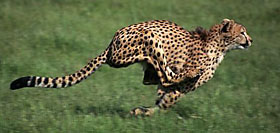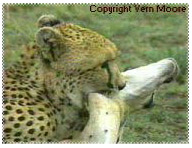This is our second design after Barry Bear, we intended him as a friend of Barry.
Cheetah we chose for its yellow fur and dark spots. Real cheetah (not our table.. ^^) the spots cover nearly the entire
body; only the white throat and abdomen are unmarked. This animal is truly built for speed!
Virtually every part of its body is adapted in some way to help it run faster.
Special paw pads and semi-retractable claws provide great traction. Large
nostrils and lungs provide quick air intake; a large liver, heart
and adrenals  also facilitate a rapid physical response. A long, fluid, greyhound-like
body is streamlined over light bones. Small collarbones and vertical shoulder
blades help lengthen the stride.
also facilitate a rapid physical response. A long, fluid, greyhound-like
body is streamlined over light bones. Small collarbones and vertical shoulder
blades help lengthen the stride.
 also facilitate a rapid physical response. A long, fluid, greyhound-like
body is streamlined over light bones. Small collarbones and vertical shoulder
blades help lengthen the stride.
also facilitate a rapid physical response. A long, fluid, greyhound-like
body is streamlined over light bones. Small collarbones and vertical shoulder
blades help lengthen the stride.
The tail acts as a rudder for quick turning
plus the eye's retinal fovea is of an elongated shape, giving the cheetah
a sharp, wide-angle view of its surroundings.
The dark tear marks beneath
each eye may also enhance its visual acuity by minimizing the sun's glare.
The spine works as a spring for the powerful back legs to give the cheetah
added reach for each step. But the great speed is very taxing physiologically.
The top speed, 114 kilometers
per hour, can usually be maintained for only 200-300 yards. (274 meters). At
that point the cheetah's body temperature increases from the exertion and
rest is mandatory.
(as said by http://www.cheetahspot.com/speed.php)
A cheetah is carnivorous wild animal
and eats a variety of small animals. While most cats are  nocturnal predators, the cheetah is primarily
diurnal, hunting in early morning and late afternoon. Since it depends on
sight rather than smell, it likes to scan the countryside from a tree limb
or the top of a termite mound. Other big cats chase only a few hundred meters:
the cheetah chases 3.4 miles (5500 meters) at an average speed of 45 miles
per hour (72 kilometers per hour). Stalking is as important as the fast
sprint: usually it will creep within 50 yards (46 meters) of an intended
victim before the final acceleration. Full sprints last about 20 seconds
and almost never exceed 1 full minute. If it succeeds in catching an animal
the cheetah will suffocate it by clamping the animal's windpipe, sometimes
holding a clamp as long as 5 minutes. Very small animals like hares are
killed by a simple bite through the skull. But whatever the meal - large
or small - cheetah eats quickly for if challenged it will most often
lose. Cheetahs have unusually clean eating habits: they do not return to
their kill nor do they eat carrion; they leave the skin, bones and entrails
of their prey. At 6 weeks the young are strong enough to follow the hunt
and when they are about 6 months old the mother will capture live prey for
them to practice killing.
nocturnal predators, the cheetah is primarily
diurnal, hunting in early morning and late afternoon. Since it depends on
sight rather than smell, it likes to scan the countryside from a tree limb
or the top of a termite mound. Other big cats chase only a few hundred meters:
the cheetah chases 3.4 miles (5500 meters) at an average speed of 45 miles
per hour (72 kilometers per hour). Stalking is as important as the fast
sprint: usually it will creep within 50 yards (46 meters) of an intended
victim before the final acceleration. Full sprints last about 20 seconds
and almost never exceed 1 full minute. If it succeeds in catching an animal
the cheetah will suffocate it by clamping the animal's windpipe, sometimes
holding a clamp as long as 5 minutes. Very small animals like hares are
killed by a simple bite through the skull. But whatever the meal - large
or small - cheetah eats quickly for if challenged it will most often
lose. Cheetahs have unusually clean eating habits: they do not return to
their kill nor do they eat carrion; they leave the skin, bones and entrails
of their prey. At 6 weeks the young are strong enough to follow the hunt
and when they are about 6 months old the mother will capture live prey for
them to practice killing.
 nocturnal predators, the cheetah is primarily
diurnal, hunting in early morning and late afternoon. Since it depends on
sight rather than smell, it likes to scan the countryside from a tree limb
or the top of a termite mound. Other big cats chase only a few hundred meters:
the cheetah chases 3.4 miles (5500 meters) at an average speed of 45 miles
per hour (72 kilometers per hour). Stalking is as important as the fast
sprint: usually it will creep within 50 yards (46 meters) of an intended
victim before the final acceleration. Full sprints last about 20 seconds
and almost never exceed 1 full minute. If it succeeds in catching an animal
the cheetah will suffocate it by clamping the animal's windpipe, sometimes
holding a clamp as long as 5 minutes. Very small animals like hares are
killed by a simple bite through the skull. But whatever the meal - large
or small - cheetah eats quickly for if challenged it will most often
lose. Cheetahs have unusually clean eating habits: they do not return to
their kill nor do they eat carrion; they leave the skin, bones and entrails
of their prey. At 6 weeks the young are strong enough to follow the hunt
and when they are about 6 months old the mother will capture live prey for
them to practice killing.
nocturnal predators, the cheetah is primarily
diurnal, hunting in early morning and late afternoon. Since it depends on
sight rather than smell, it likes to scan the countryside from a tree limb
or the top of a termite mound. Other big cats chase only a few hundred meters:
the cheetah chases 3.4 miles (5500 meters) at an average speed of 45 miles
per hour (72 kilometers per hour). Stalking is as important as the fast
sprint: usually it will creep within 50 yards (46 meters) of an intended
victim before the final acceleration. Full sprints last about 20 seconds
and almost never exceed 1 full minute. If it succeeds in catching an animal
the cheetah will suffocate it by clamping the animal's windpipe, sometimes
holding a clamp as long as 5 minutes. Very small animals like hares are
killed by a simple bite through the skull. But whatever the meal - large
or small - cheetah eats quickly for if challenged it will most often
lose. Cheetahs have unusually clean eating habits: they do not return to
their kill nor do they eat carrion; they leave the skin, bones and entrails
of their prey. At 6 weeks the young are strong enough to follow the hunt
and when they are about 6 months old the mother will capture live prey for
them to practice killing.
(as said by http://www.cheetahspot.com/food.php)
Cheetah is a wild animal, but through our imagination we created cheetah as a cute and friendly animal, and we named it Chito Cheetah... ^^

No comments:
Post a Comment